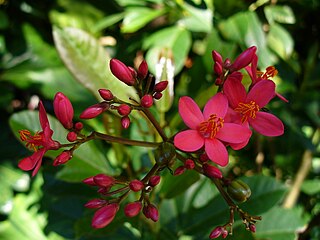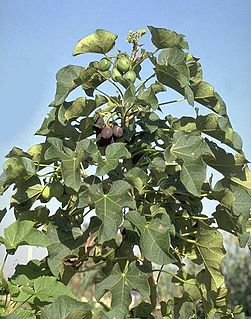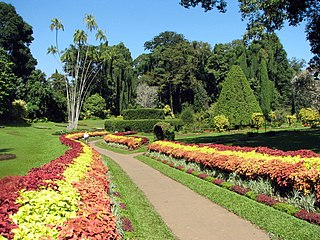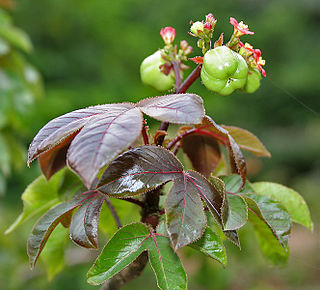
Jatropha is a genus of flowering plants in the spurge family, Euphorbiaceae. The name is derived from the Greek words ἰατρός (iatros), meaning "physician", and τροφή (trophe), meaning "nutrition", hence the common name physic nut. Another common name is nettlespurge. It contains approximately 170 species of succulent plants, shrubs and trees. Most of these are native to the Americas, with 66 species found in the Old World. Plants produce separate male and female flowers. As with many members of the family Euphorbiaceae, Jatropha contains compounds that are highly toxic. Jatropha species have traditionally been used in basketmaking, tanning and dye production. In the 2000s, one species, Jatropha curcas, generated interest as an oil crop for biodiesel production and also medicinal importance when used as lamp oil; native Mexicans in the Veracruz area developed by selective breeding a Jatropha curcas variant lacking the toxic compounds, yielding a better income when used as source for Biodiesel, because of its edible byproduct. Toxicity may return if edible Jatropha is pollinated by toxic types.

Croton is an extensive flowering plant genus in the spurge family, Euphorbiaceae. The plants of this genus were described and introduced to Europeans by Georg Eberhard Rumphius. The common names for this genus are rushfoil and croton, but the latter also refers to Codiaeum variegatum. The generic name comes from the Greek κρότος, which means "tick" and refers to the shape of the seeds of certain species.

Manihot is a genus in the diverse milkspurge family, Euphorbiaceae. It was described as a genus in 1754.

The Kingwood Center Gardens is a historic 47-acre (190,000 m2) site with a house, gardens and greenhouses, located at 50 N. Trimble Road in Mansfield, Ohio.
Coral plant is a common name for several flowering plants and may refer to:

Banksia bipinnatifida is a species of shrub that is endemic to Western Australia. It is a prostrate shrub with a lignotuber, an underground stem, only a few divided leaves, large cream-coloured to pale yellow flowers and large fruit.

Jatropha curcas is a species of flowering plant in the spurge family, Euphorbiaceae, that is native to the American tropics, most likely Mexico and Central America. It is originally native to the tropical areas of the Americas from Mexico to Argentina, and has been spread throughout the world in tropical and subtropical regions around the world, becoming naturalized or invasive in many areas. The specific epithet, "curcas", was first used by Portuguese doctor Garcia de Orta more than 400 years ago. Common names in English include physic nut, Barbados nut, poison nut, bubble bush or purging nut. In parts of Africa and areas in Asia such as India it is often known as "castor oil plant" or "hedge castor oil plant", but it is not the same as the usual castor oil plant, Ricinus communis.
Jatropha unicostata is a species of plant in the family Euphorbiaceae. It is endemic to Socotra island Yemen. Its name in Soqotri is "sibru". Its natural habitat is subtropical or tropical dry forests.
Manilkara multifida is a species of plant in the family Sapotaceae.

Royal Botanic Gardens, Peradeniya are about 5.5 km to the west of the city of Kandy in the Central Province of Sri Lanka. It attracts 2 million visitors annually. It is near the Mahaweli River. It is renowned for its collection of orchids. The garden includes more than 4000 species of plants, including orchids, spices, medicinal plants and palm trees. Attached to it is the National Herbarium of Sri Lanka. The total area of the botanical garden is 147 acres (0.59 km2), at 460 meters above sea level, and with a 200-day annual rainfall. It is managed by the Division of National Botanic Gardens of the Department of Agriculture.

Jatropha podagrica is a succulent plant in the family Euphorbiaceae. It is native to the tropical Americas but is grown as an ornamental plant in many parts of the world due to its unusual appearance. Common names include Gout Plant, Gout Stalk, Guatemalan Rhubarb, Coral Plant, Buddha Belly Plant, Purging-Nut, Physic Nut, Goutystalk Nettlespurge, Australian Bottle Plant, and Tartogo.

Pulsatilla patens is a species of flowering plant in the family Ranunculaceae, native to Europe, Russia, Mongolia, and China. Common names include Eastern pasqueflower and cutleaf anemone.

Jatropha cathartica is a species of flowering plant in the spurge family, Euphorbiaceae, that is native to Texas in the United States and Coahuila, Nuevo León and Tamaulipas in northeastern Mexico. Common names include jicamilla (Spanish) and Berlandier's nettlespurge.

Brachyscome multifida is a perennial herb in the family Asteraceae. Common names include cut-leaved daisy, rocky daisy, and Hawkesbury daisy. The species is endemic to Australia.

Pulsatilla nuttalliana, known as American pasqueflower, prairie pasqueflower, prairie crocus, cutleaf anemone, or simply pasqueflower, is a flowering plant native to much of North America, from the western side of Lake Michigan, to northern Canada in the Northwest Territories, south to New Mexico in the southwestern United States.

Jatropha gossypiifolia, commonly known as bellyache bush, black physicnut or cotton-leaf physicnut, is a species of flowering plant in the spurge family, Euphorbiaceae. The species is native to Mexico, South America, Gujarat State (India) and the Caribbean islands. It is a declared noxious weed in Puerto Rico and is naturalised in northern Australia, including Queensland where it is listed as a Class 2 declared pest plant. It grows to 2.5–4 m (8.2–13.1 ft) high. The three lobed leaves are purple and sticky when young and become bright green with age. The small red flowers with yellow centres appear in clusters. These are followed by cherry-sized seed pods that are poisonous. Powdery mildew fungal disease was reported.

Jatropha dioica is a species of flowering plant in the spurge family, Euphorbiaceae, that is native to Texas in the United States as well as Mexico as far south as Oaxaca. Common names include leatherstem and sangre de drago. The specific name refers to the dioecious nature of the plants.

Leucospora multifida, known variously as Obi-Wan conobea, narrow-leaved paleseed, cliff conobea, cut-leaved conobea, or much-cleft conobea, is an annual herb in the plantain family, Plantaginaceae, and the only species in the North American genus Leucospora.
Coral bush may refer to various flowering plants:















